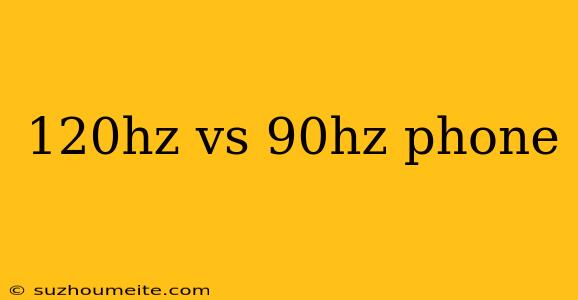120Hz vs 90Hz Phone: What's the Difference?
When it comes to choosing a new smartphone, there are several factors to consider, including the display refresh rate. In recent years, we've seen a trend towards higher refresh rates, with some phones featuring 90Hz or even 120Hz displays. But what does this mean, and is it worth the upgrade?
What is a Refresh Rate?
The refresh rate of a display refers to the number of times the image on the screen is updated per second. It's measured in Hertz (Hz), and a higher refresh rate means a smoother and more responsive user experience.
90Hz Display: The Standard for Flagships
Until recently, the standard refresh rate for most smartphones was 60Hz. However, with the introduction of high-end flagships, manufacturers started to move towards 90Hz displays. This provided a noticeable improvement in terms of smoothness and responsiveness, making tasks like scrolling, gaming, and watching videos a more enjoyable experience.
120Hz Display: The New Benchmark
The latest trend in smartphone displays is the move towards 120Hz refresh rates. This is a significant jump from the standard 90Hz, and it promises an even more immersive and responsive experience.
With a 120Hz display, you can expect:
- Smoother animations: Transitions between apps, scrolling, and other animations will be even more fluid and natural.
- Improved gaming: Games that support higher refresh rates will benefit from reduced screen tearing and a more responsive gaming experience.
- Enhanced video: Watching videos will be more enjoyable, with reduced blur and a more cinematic feel.
Key Differences: 120Hz vs 90Hz
So, what are the key differences between a 120Hz and 90Hz display?
Refresh Rate
- 120Hz: 120 times per second
- 90Hz: 90 times per second
Smoothness and Responsiveness
- 120Hz: Even smoother and more responsive than 90Hz
- 90Hz: Smoother and more responsive than 60Hz, but less so than 120Hz
Power Consumption
- 120Hz: Generally consumes more power than 90Hz
- 90Hz: Consumes less power than 120Hz, but more than 60Hz
Availability
- 120Hz: Currently available on select high-end flagships
- 90Hz: Widely available on mid-range to high-end smartphones
Is a 120Hz Display Worth It?
So, is a 120Hz display worth the upgrade? If you're a:
- Gamer: A 120Hz display can provide a competitive edge and a more immersive gaming experience.
- Power user: If you're someone who demands the best performance and smoothest experience, a 120Hz display might be worth the investment.
- Casual user: If you're a casual user who primarily uses their phone for social media, browsing, and watching videos, a 90Hz display might be sufficient.
In conclusion, a 120Hz display offers a significant improvement over a 90Hz display, but it comes at a cost – increased power consumption and a higher price point. Ultimately, the decision to upgrade to a 120Hz display depends on your specific needs and preferences.
